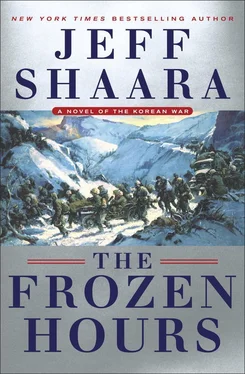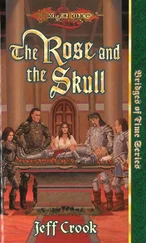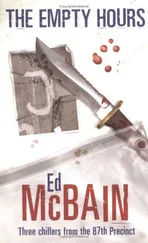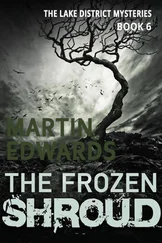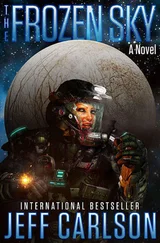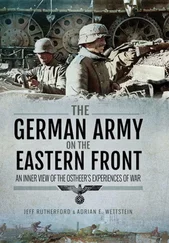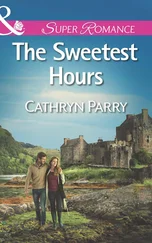NEAR PUNGNYURI INLET, CHOSIN RESERVOIR—DECEMBER 1, 1950, EARLY AFTERNOON
The withdrawal of the army’s Thirty-first and Thirty-second Regimental Combat Teams had begun close to noon, Lieutenant Colonel Don Faith ordering all army units along the east side of the reservoir to assemble for a forceful drive southward, hoping to push through the enemy that surrounded them. Hagaru-ri was barely ten miles away, though Faith had wanted to believe that either army or Marine units had shortened that gap, pushing out to meet him, at least halfway. What Faith did not know was that General Henry Hodes had given the order that the forces closest to any rescue, the men who had held to the village of Sudong-ni, be withdrawn, Hodes and General Barr believing that their position was too vulnerable and too useless to add any support to Faith’s hemmed-in command.
The order for Faith’s men to withdraw had come from him alone, without any authority received from the base at Hagaru-ri. That would change, the order finally passed through the haphazard communication network of aircraft and tank radios, the signal suddenly clearing just enough so that Faith could understand that General Smith was now in command, and that Smith had ordered Faith to do all he could to withdraw back to Hagaru-ri. By that time, Faith’s men had already been in motion for more than two hours.
They formed a convoy around a lengthy line of thirty six-bys, plus a number of smaller trucks. Most of the smaller vehicles were ordered by Faith to be destroyed, along with most of the remaining supplies, and the excess clothing and gear carried by the men. The trucks were emptied of their cargo, fitted instead to carry the hundreds of wounded men, the casualties of four days of assaults by the Chinese.
As the withdrawal began, the Chinese were clearly aware what Faith was attempting to do, the gathering of men and vehicles plainly visible from the surrounding heights. Almost immediately, mortar and machine gun fire raked the column, and as the trucks began to file out into the road, Chinese infantry moved closer, adding their fire to the assault. Very soon the air support that Smith had promised began to arrive, twenty Marine Corsairs pouring out their fire along the road, holding the Chinese away. But the chaos and confusion of the advance under fire was made worse by one terrible accident, a Corsair dropping a napalm canister that impacted short of its intended target. The fiery blast spread out through the first ranks of the American and South Korean troops, engulfing more than a dozen men, some killed outright, the rest suffering the horror of devastating burns. The sight of the blast produced panic in the men who saw it, halting the advance, as Faith’s men recoiled from the scene. Some of the Americans scrambled to assist the wounded, helping them onto the trucks, adding to the misery of their human cargo. But Faith and his officers pushed their men and the vehicles to resume the advance, no matter the waves of Chinese fire pressing down from all sides.
For the first mile of their breakthrough from their own perimeter, the Americans were continuously supported by the aircraft, but even with the planes overhead, the column continued to dissolve into a chaotic mob. Many of the men attempted to escape the incoming Chinese fire by climbing aboard the trucks, the untrained South Koreans especially unwilling to stand up in the fight. But the Chinese would not ignore the fat, slow-moving targets, the trucks with their wounded men inside, absorbing as much machine gun fire as the infantry making their way along the road on foot.
Some two hours after they began, the convoy reached the first major roadblock, a wrecked bridge, the vehicles forced to halt. Though some of the drivers attempted to push their way across the shallow frozen marsh, for most of the vehicles the terrain was simply too difficult. Finally, with the Chinese pouring fire onto the men who gathered near the bridge, a single tracked vehicle was put to use, towing the trucks across the marsh one at a time, a process that took the better part of two hours. When the column was finally able to get under way, it was nearly dark.
With most of the column now in complete confusion, the Chinese began to press their advantages, pushing up closer to the flanks and rear of the march. The darkness meant the end of the air support, and with the Corsairs now unable to assist, the increasing pressure from the Chinese pushed Faith’s men into further chaos, most of the column now completely disorganized. Though some of the trucks continued to roll, the Chinese had effectively targeted the truck drivers, the sudden breakdowns requiring some of the Americans to demonstrate an astonishing brand of courage, climbing up into the driver’s seats knowing they would likely be the next casualty. But the greatest obstacle lay still to their front, Hill 1221, which anchored the strongest Chinese position yet alongside the reservoir. As the convoy rolled up, the infantry who could still advance began to scatter, some men pushing their way up the hill itself, leaving the road and the vehicles behind. Some men re-formed into small groups, some were alone, all of them climbing up through the darkness, some confronted by Chinese machine gun fire, others slipping undetected past Chinese positions. Despite the best efforts of several officers who attempted to organize a strike at the roadblock itself, most of the men had absorbed all the horror they could take.
Adding to the pressure from the Chinese closer to the road, Faith’s rearguard troops, assigned to keep the Chinese off the tail of the convoy, completely broke down. Many of those men rushed forward, adding to the chaos around the trucks, many more seeking escape by climbing up away from the road. With nothing to hold them back, the Chinese pressed hard into the rear of the column, swarming around the stalled vehicles.
At the roadblock itself, Colonel Faith and several of his officers, including a number of badly wounded men, succeeded in gathering enough troops to drive the Chinese away. With the road now open, many of the trucks continued on slowly. As they reached yet another destroyed bridge, the Chinese pressed even closer and in greater strength, many Chinese troops continuing to reach the trucks themselves. The casualties continued to mount, some of the wounded in the trucks now helplessly exposed to Chinese grenades and close-range rifle fire. As he continued to lead his men through the relentless gauntlet, Colonel Faith became one more casualty, taking a deadly wound to the heart from a Chinese grenade. He died in the cab of one of his lead trucks.
By full dark, it was over. Some of those who survived crossed over or around Hill 1221, linking up with others, all of them walking or staggering toward the perimeter at Hagaru-ri. Others made a different escape, a desperate gamble as they walked out onto the ice of the frozen reservoir, taking aim at the glimmer of light reflected from the engineers, still working their heavy equipment on the airstrip.
Though many of the wounded men in the stalled trucks were pulled out, most of those could not walk on their own. With no one remaining to help, many of those men had no choice but to remain along the base of Hill 1221, only to succumb to their wounds, the cold, or the Chinese who found them. In the trucks themselves, those still alive were virtually indistinguishable from those who had died along the way, the men often stacked three deep. After rifling through the trucks for anything worth salvaging, the Chinese troops burned the trucks, and the bodies of the men still inside.
Throughout the next day, and for three days after, the survivors of Task Force Faith straggled into the Marine lines at Hagaru-ri. The Americans had left behind every vehicle, every piece of equipment, including every heavy weapon, and most of the small arms carried by the troops themselves. Though approximately two-thirds of Faith’s men eventually reached Hagaru-ri, the majority of those were wounded, many severely. Roughly one thousand men did not survive, their bodies never recovered.
Читать дальше
